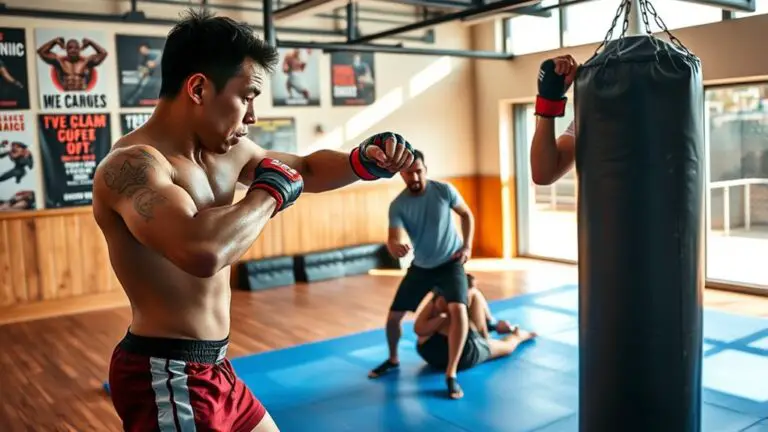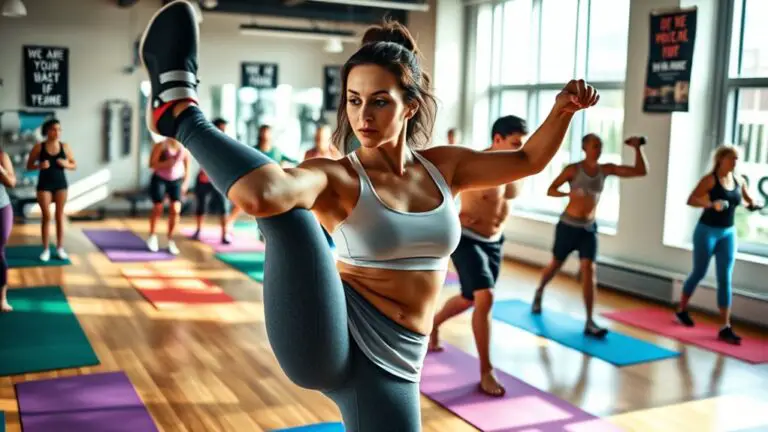The Best Gym Workouts for Seniors Over 60
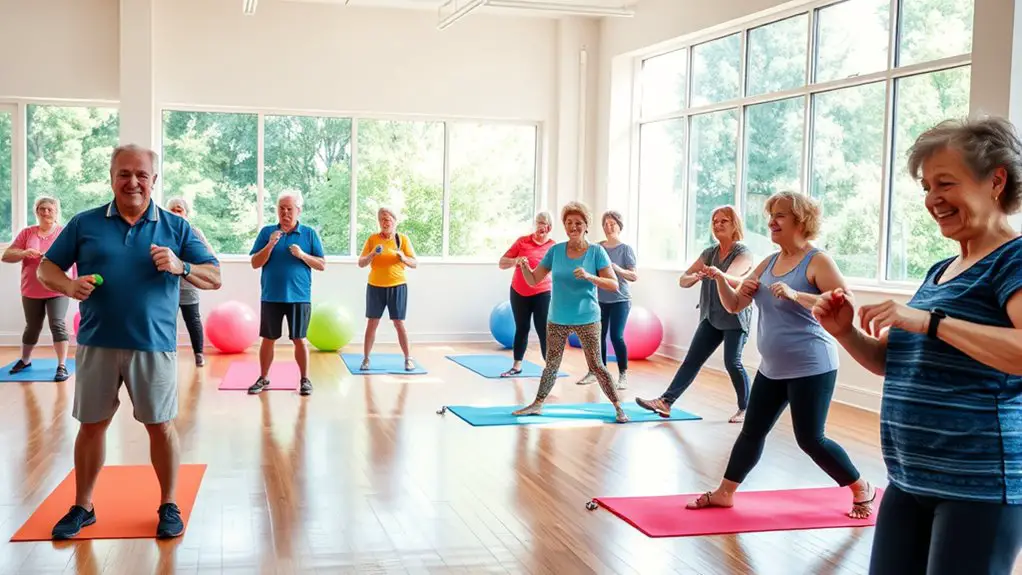
The best gym workouts for seniors over 60 focus on low-impact exercises that boost strength, flexibility, balance, and cardiovascular health. You should incorporate strength training with resistance bands, gentle stretching routines, and balance exercises like standing on one leg. Low-impact cardio options like walking or swimming are fantastic for heart health. Always prioritize safety and hydration while setting personal fitness goals. By exploring various exercises, you’ll discover what works best for you and how to stay motivated.
Importance of Exercise for Seniors
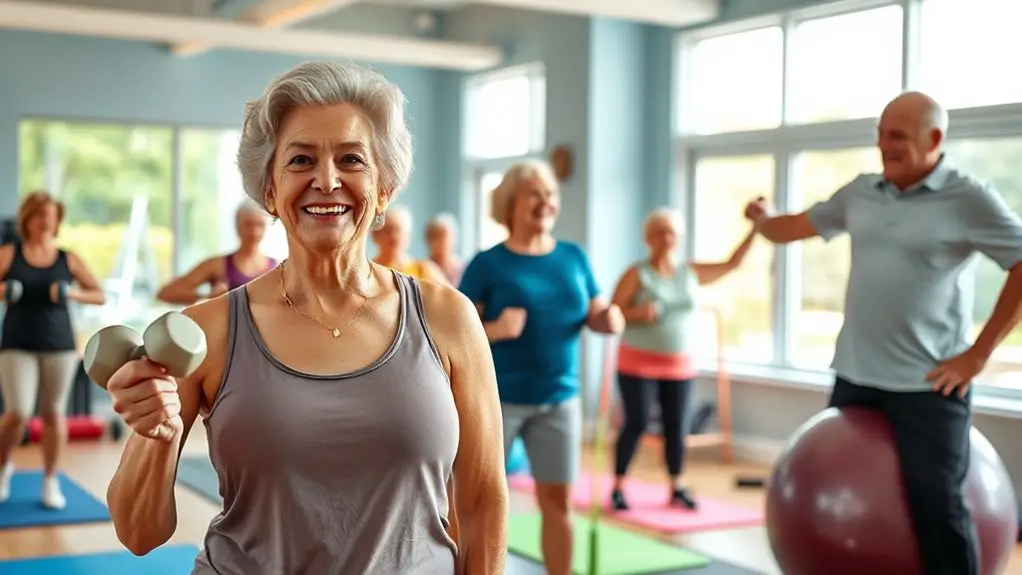
As you age, staying active becomes even more essential for maintaining your health and well-being. Regular exercise offers numerous health benefits, such as improved cardiovascular health, better balance, and increased flexibility. These advantages can help reduce the risk of falls and injuries, allowing you to enjoy life more fully. Engaging in physical activity also promotes social engagement, connecting you with others who share similar interests. Whether it’s joining a walking group or participating in group classes, these interactions can enhance your mood and contribute to a sense of community. To guarantee safety, it’s important to choose low-impact exercises that suit your abilities and comfort level. Always consult with a healthcare professional before starting any new workout routine. By prioritizing exercise, you not only improve your physical health but also enrich your social life, creating a more fulfilling lifestyle as you age. Additionally, incorporating low-impact exercises like skipping rope can provide a gentle yet effective workout that benefits both your heart and muscles.
Strength Training Exercises
Strength training can bring numerous benefits as you age, including improved muscle strength and better balance. It’s crucial to incorporate exercises that are safe and effective for your body. Let’s explore some recommended strength training exercises tailored specifically for seniors like you.
Benefits of Strength Training
Building strength offers numerous benefits for seniors over 60, enhancing both physical and mental well-being. Engaging in strength training can greatly improve your muscle preservation, which is essential as you age. It also supports metabolic health, helping you maintain a healthy weight and energy levels. Here are some key benefits of strength training:
- Improved balance and stability: This reduces the risk of falls and injuries.
- Enhanced mood and cognitive function: Regular strength training can boost mental clarity and emotional health.
- Increased independence: Strengthening your muscles can help you perform daily activities with ease.
Recommended Exercises for Seniors
Incorporating strength training exercises into your routine can be transformative for seniors over 60. Focus on low-impact chair exercises to build strength safely. For instance, seated leg lifts and arm raises can enhance your mobility and stability without straining your body. Resistance bands are another excellent option; they provide adjustable resistance and can be used for various exercises like seated rows and bicep curls. These exercises not only help strengthen muscles but also improve balance and coordination. Remember to start slowly and listen to your body. It’s crucial to consult with a professional trainer or physician before beginning any new workout regimen, ensuring that you choose the right exercises for your individual needs. Stay safe and enjoy your fitness journey!
Flexibility and Stretching Routines

Many seniors over 60 find that incorporating flexibility and stretching routines into their gym workouts enhances overall mobility and reduces the risk of injury. To safely improve flexibility, consider these effective practices:
- Dynamic stretching: Start your workout with gentle movements that warm up your muscles and joints. This can include arm circles or leg swings, preparing your body for more intense activity.
- Yoga poses: Incorporating simple yoga poses like the Cat-Cow or Child’s Pose can help maintain flexibility and promote relaxation. These poses can be modified to suit your comfort level.
- Cool down stretches: After your workout, spend a few minutes on static stretches to help your muscles recover. Focus on major muscle groups, holding each stretch for 15-30 seconds.
These routines can make a significant difference in your overall fitness and well-being, ensuring you stay active and injury-free.
Balance and Stability Workouts
Since maintaining balance and stability becomes increasingly important as we age, incorporating specific workouts into your routine can greatly enhance your overall safety and mobility. Balance exercises, such as standing on one leg or using a stability ball, can help improve your core strength and coordination. You might also try simple yoga poses, like the tree pose, which fosters focus and stability.
In addition to these exercises, stability drills like walking heel-to-toe and practicing gentle lunges can further strengthen your muscles and enhance your sense of balance. Consider using a chair for support during these activities, ensuring you feel secure while working on your stability.
Cardio Options for Seniors
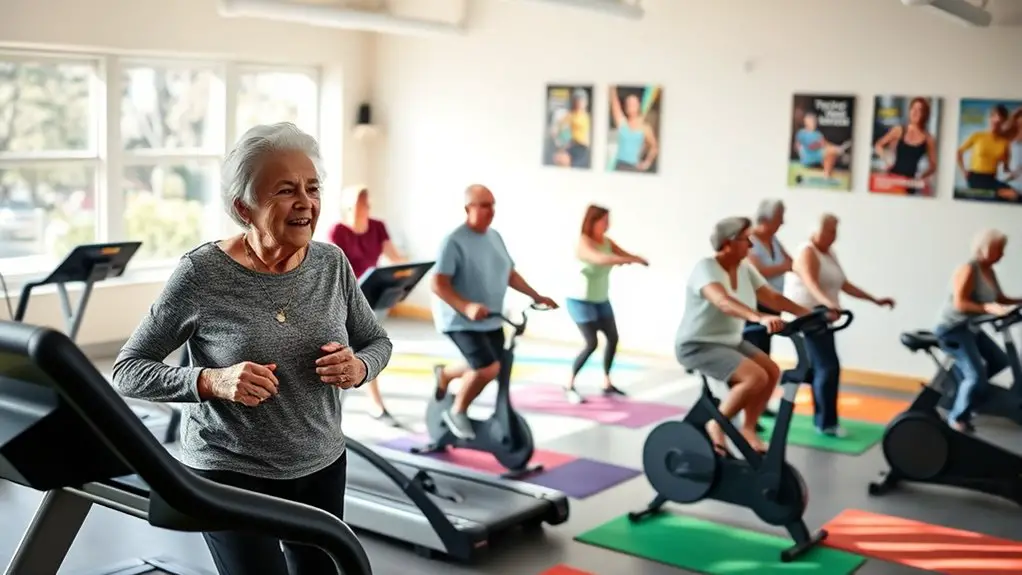
While staying active is essential for maintaining heart health, seniors can explore a variety of enjoyable cardio options that fit their needs. Focusing on low impact exercises can make your workouts safe and effective. Here are some great aerobic activities to contemplate:
- Walking: A simple yet effective way to boost your heart rate without too much strain.
- Swimming: Provides a full-body workout while being gentle on your joints.
- Cycling: Whether on a stationary bike or outdoors, cycling is fantastic for cardiovascular health.
These options allow you to engage in physical activity without risking injury. Always remember to listen to your body and start slow, gradually increasing the intensity as you feel comfortable. This way, you’ll enjoy your cardio workouts while prioritizing your safety and well-being.
Tips for Safe Gym Workouts
When you’re heading to the gym, it’s essential to prioritize safety. Start with warm-up exercises to prepare your body, and make sure you’re using the right equipment for your workouts. Most importantly, always listen to your body and adjust your routine as needed.
Warm-Up Exercises Importance
Warm-up exercises are essential for ensuring a safe and effective workout, especially for seniors over 60. They help prepare your body for more intense activity, reduce the risk of injury, and improve overall performance. Incorporating dynamic warm-ups can enhance joint mobility and flexibility, making your workouts more enjoyable.
Consider these warm-up tips:
- Start slow: Begin with gentle movements to gradually increase your heart rate.
- Focus on joints: Include exercises that promote joint mobility, such as arm circles and leg swings.
- Engage your muscles: Activate major muscle groups with dynamic stretches, like walking lunges or torso twists.
Proper Equipment Usage
After you’ve completed your warm-up, knowing how to use gym equipment properly is essential for maintaining safety and maximizing your workout effectiveness. Always read the instructions or ask a trainer for guidance if you’re unsure. Adjust the equipment to fit your body; this guarantees comfort and reduces the risk of injury. Pay attention to gym accessibility features, like handrails and seat adjustments, which can make your workout safer. When lifting weights, start with lighter loads and focus on your form; this helps prevent strains. Don’t rush through your exercises; take your time to execute each movement correctly. By prioritizing proper equipment usage, you’ll enjoy a safer, more effective workout experience tailored to your needs.
Listen to Your Body
Listening to your body is essential for safe gym workouts, especially as you age. Being mindful of your body signals helps prevent injuries and guarantees a productive experience. Here are some tips for practicing mindful movement:
- Pay attention to discomfort: If you feel pain, stop the activity immediately. Distinguish between normal exertion and potential injury.
- Adjust intensity: Modify your workouts based on how you feel. It’s okay to take it slow or use lighter weights on tougher days.
- Stay hydrated and rested: Listen to your hydration needs and make sure you’re getting enough rest. Fatigue can impact your performance and safety.
Creating a Personalized Workout Plan
Creating a personalized workout plan can be a game changer for seniors over 60, as it guarantees that exercises align with your specific fitness goals and abilities. Start with a fitness assessment to understand your current health status and any limitations. This assessment helps identify areas where you can improve, whether it’s strength, flexibility, or endurance.
Next, set clear personal goals. Do you want to enhance mobility, build strength, or maintain cardiovascular health? Establishing these objectives will guide your workout choices.
Incorporate a mix of activities, such as walking, strength training, and balance exercises, while always prioritizing safety. It’s essential to listen to your body and adjust your plan as needed. Consider consulting a fitness professional who specializes in senior fitness to confirm your plan is well-rounded and effective. Remember, consistency is key, so find activities you enjoy to keep you motivated and engaged!
Frequently Asked Questions
What Gym Equipment Is Safest for Seniors to Use?
When considering what gym equipment’s safest for you, low impact machines like stationary bikes and elliptical trainers are great options. They reduce strain on your joints while providing effective workouts. Resistance bands are also excellent, as they offer versatility and can be adjusted to your strength level. Always remember to start slow, listen to your body, and consult with a trainer if you’re unsure about using any equipment safely.
How Often Should Seniors Work Out Each Week?
When considering how often you should work out each week, it’s important to focus on exercise frequency that feels right for you. Aim for at least 150 minutes of moderate-intensity aerobic activity, spread across the week, along with strength training on two or more days. This balanced approach in your weekly routines can enhance your overall health. Always listen to your body and consult a professional to guarantee safety in your workouts.
Can Seniors Exercise With Chronic Health Conditions?
You might think that chronic conditions mean you can’t exercise safely, but that’s not true. In fact, with the right exercise modifications, you can benefit greatly from physical activity. Low-impact workouts, gentle stretching, or even walking can be tailored to meet your needs. Always consult your healthcare provider before starting any program, ensuring that your chosen activities are safe and effective for your specific health situation. Remember, staying active is essential for overall well-being!
What Should Seniors Eat Before and After Workouts?
When considering what to eat before and after workouts, it’s important to focus on nutrient timing. Before exercising, you should have a light meal or snack that includes carbohydrates and protein to fuel your body. After your workout, aim for a balanced meal to help with recovery. Meal planning can help guarantee you’re getting the right nutrients at the right times, promoting safety and peak performance while exercising.
How Can Seniors Stay Motivated to Exercise Regularly?
Staying motivated to exercise regularly can be challenging, but setting clear fitness goals can help. Start by choosing achievable targets that excite you. Mix up your routine to keep things fresh, and consider working out with a friend for added support. You could also track your progress to see how far you’ve come, which can boost your exercise motivation. Remember, safety’s key, so always listen to your body and adjust as needed.
